Booking Information
Crystallography is the science of the arrangement of atoms in molecules and of the arrangement of molecules with respect to each other.
The X-Ray Crystallography Facility as part of the Department of Chemistry provides single crystal X-ray (for small molecules) for Chemistry, Material Sciences, etc. The facility is used by departmental members, but is also available for academic users from other departments within and other academic and industrial institutions outside Queen’s University.
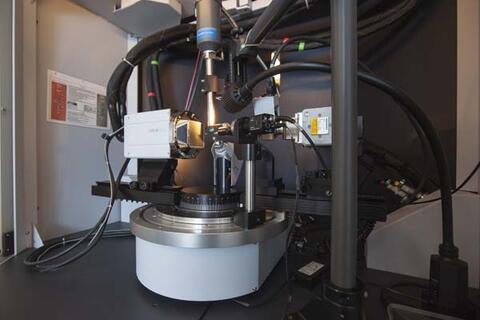
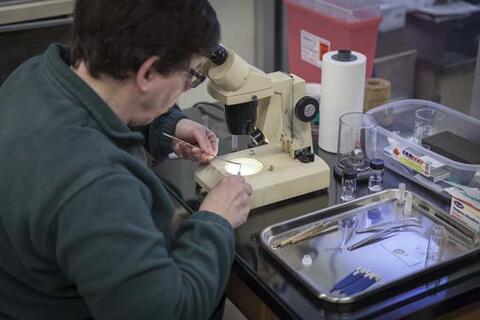
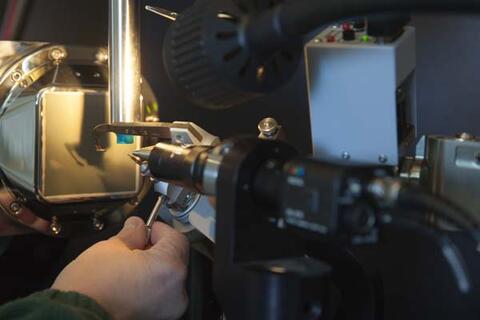
Crystallography borders, naturally, on pure physics, chemistry, biology, mineralogy, technology and also on mathematics, but is distinguished by being concerned with the methods and results of investigating the arrangement of atoms in matter, particularly when that arrangement has regular features [Paul P. Ewald, Acta Crystallographica (1948), 1, 2].
Note: Crystals, which cannot be measured on this instrument because they are too small, can be sent to the Canadian Light source in Saskatoon, SK. The data sets will be collected remotely and processed in-house.
Service Packages
The X-ray Crystallography Facility offers the following services associated with single crystal structure analyses of small molecules. The estimated service hours are given behind the service packages:
| PAK-1 |
|
| PAK-2 |
|
| PAK-3 |
Included
Optional Services
|
Fees
Internal Users
- PAK-1: $20 per hour
- PAK-2: $150 (Note: Unsuccessful attempt of data collection: service hours *$20, 1 hr minimum and 5hr maximum)
- PAK-3: $230
- Optional Service: service hours * $20
External Academic Users
- PAK-1: $30 per hour
- PAK-2: $200 (Note: Unsuccessful attempt of data collection: service hours *$20, 1 hr minimum and 5hr maximum)
- PAK-3: $400
- Optional Service: service hours * $30
Industrial Users
- PAK-1: $100 per hour
- PAK-2: $300 (Note: Unsuccessful attempt of data collection: service hours *$20, 1 hr minimum and 5hr maximum)
- PAK-3: $600
- Optional Service: service hours * $40
- Advice on how to crystallize quality crystals suitable for X-ray diffraction
- Mounting of crystals, including air, moisture and temperature sensitive samples
- Determination of unit cell parameters
- Accurate data collection at room or low temperature
- Data reduction and absorption correction
- Structure solution and refinement
- Validation of the data
- Detailed report with tables of coordinates and molecular geometry
- Preparation of high quality molecular plots
- Providing help with Cambridge Crystallographic Database
The following flow chart provides an overview of the steps in the determination of a structure:
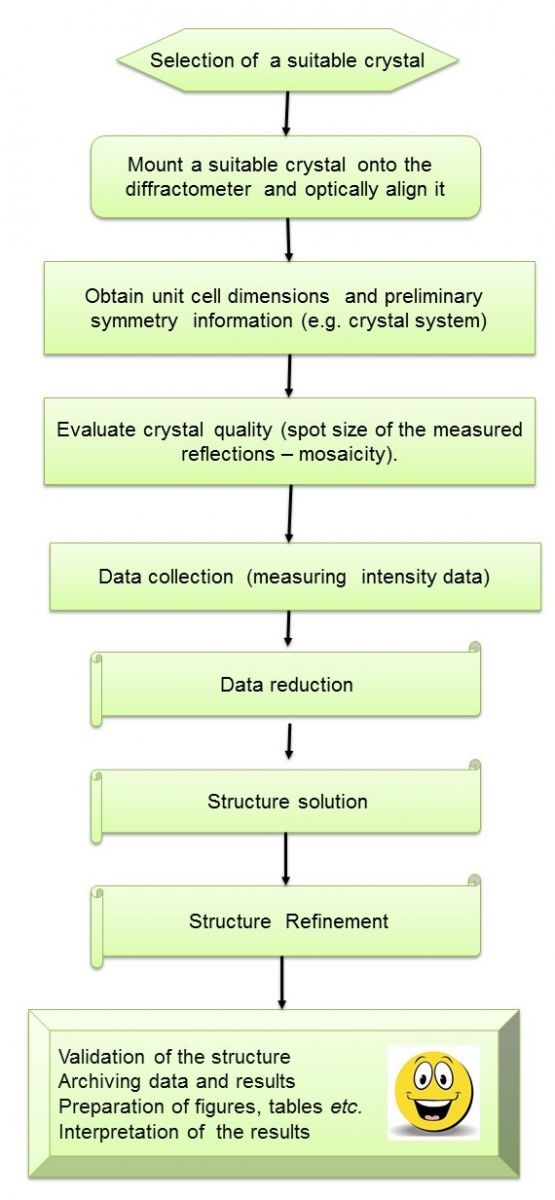
The analysis of a single crystal X-ray structure results in:
a) Bond distance, bond angles and torsion angles between atoms;
b) Determination of the absolute conformation;
c) Identification of solvent molecules present in crystal lattice;
d) Identification of intra- and/or inter-molecular interactions (e.g. hydrogen bonding).
e) Packing diagrams, which show the arrangement of the molecules within unit cells and can reveal the presence of channels, voids, helices etc.
In addition, the X-ray powder pattern can be calculated and the results can be used to identify the bulk of material via X-ray powder diffraction.
The X-ray crystallography facility is equipped with a state-of-the-art Smart Apex2 D85 diffractometer. The diffractometer is equipped with a CCD based Apex2 detector cooled to -55 ºC using graphite 24monochromated Mo-Kαradiation {17.44 keV; λ(Mo Kα): 0.71073 Å} from a sealed fine-focus ceramic tube X-ray tube and a K780 X-ray generator.
The system uses a horizontal-oriented D8 3circle goniometer base with 2-theta, omega and phi drivesand a fixed chi stage with an angle of 54.74º.
A monocap collimator of 0.5 mm in diameter is used. The MonoCap™ collimator is an assembly of a single glass tube mounted into a metal holder. The glass tube works as an X-ray guide using the effect of total external reflection for focusing and collimating X-ray beams. Data collections can be performed at ambient or lower temperatures using the Oxford Cryosystems 700 Series Cryostream cooling system (temperature range: 90 to 300 K).
Note: Crystals, which cannot be measured on this instrument because they are too small, can be sent to the Canadian Lightsource in Saskatoon, SK. The data sets will be collected remotely and processed in-house.
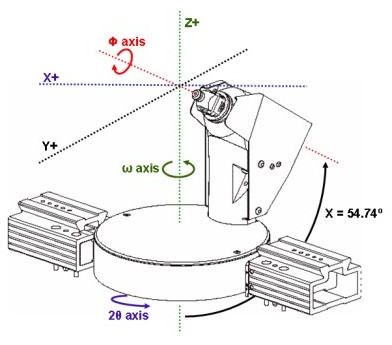
The following suites of programs are installed on the client computer:
- APEX2 – Software controlling the diffractometer, used for data collection and data processing. Designed by Bruker AXS.
- WinGX - A MS-Windows based system of programs for solving, refining and analyzing single crystal X-ray diffraction data for small molecules. Has a very user-friendly GUI. Louis Farrgia's WinGX - Tutorials and Examples - software downloads
- Olex2 - Program for small-molecule structure solution and refinement. It also includes many useful tools for structure analysis, archiving and report genera¬tion. http://www.olex2.org/
- Platon - Program is designed as a Multipurpose Crystallographic Tool: routines for standard geometrical calculations (bonds distances, angles, torsions, planes, rings, intra- and inter-molecular contacts), test programs for missing symmetry, voids in the lattice etc.), utility programs (cell transformations, SHELXL input file etc.), programs for structure validation. http://www.platonsoft.nl/platon/pl000000.html
- SIR97, SIR2002, SIR2004, SIR2011, SHELXS - Programs for structure solution. http://www.ic.cnr.it/icnew/site/ and http://shelx.uni-ac.gwdg.de/SHELX/
- Shelxle - graphical user interface for SHELXL (Sheldrick, G. M. (2008). Acta Cryst. A64, 112-122), program used for the refinement of small molecule structures.
- Mercury – Program for .3D structure visualization and the exploration of crystal packing. http://www.ccdc.cam.ac.uk/Solutions/FreeSoftware/Pages/FreeMercury.aspx
- CheckCIF, PublCIF and EnCIFer are useful for checking and manipulating CIF files.
- Cambridge Crystallographic Database Centre (CCDC)
| Address
Department of Chemistry |
Phone
Office: 613-533-6000 ext. 74474 |
Hours
Monday to Friday |
Contact Information

Dr. Gabriele Schatte
Instrumentation Manager
Email: gabriele.schatte@chem.queensu.ca